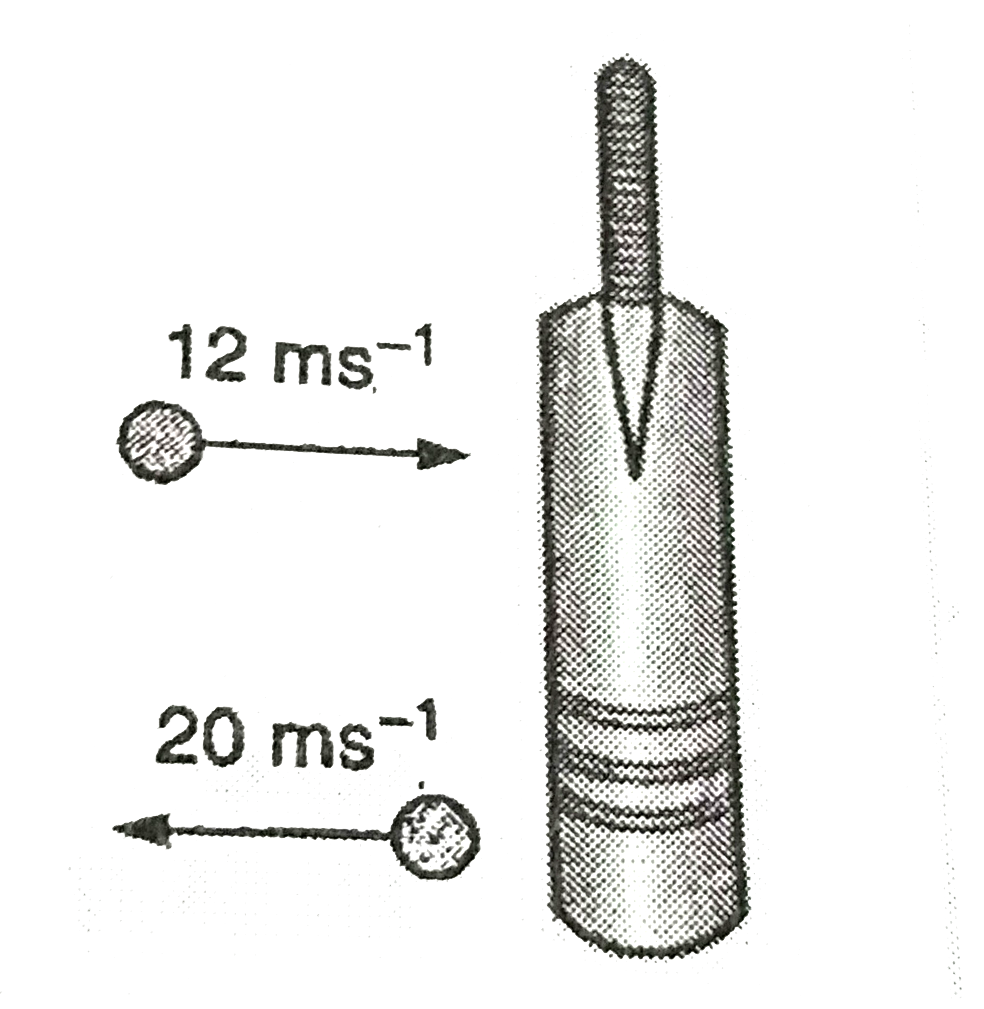A cricket ball of mass 100 g moving with a speed of 30ms−1 is brought to rest by a player in 0.03 s. Find the average force applied by the player.
To solve the problem of finding the average force applied by the player to bring a cricket ball to rest, we can follow these steps:
1. Convert Mass from grams to kilograms:
- Given mass of the cricket ball = 100 g
- To convert grams to kilograms, we divide by 1000.
Mass (m)=100 g1000=0.1 kg
2. Identify Initial and Final Velocities:
- Initial velocity (vi) = 30 m/s (the speed of the ball before it is brought to rest).
- Final velocity (vf) = 0 m/s (the speed of the ball after it is brought to rest).
3. Determine the Time Interval:
- The time taken to bring the ball to rest (t) = 0.03 s.
4. Use the Formula for Average Force:
- The formula for average force (F) is given by:
F=m⋅(vf−vi)t
- Substituting the values we have:
F=0.1⋅(0−30)0.03
5. Calculate the Change in Velocity:
- The change in velocity (vf−vi) = 0−30=−30 m/s.
6. Substitute the Change in Velocity into the Force Equation:
F=0.1⋅−300.03
7. Calculate the Division:
- Calculate −300.03:
−300.03=−1000
8. Calculate the Average Force:
F=0.1⋅(−1000)=−100 N
9. Interpret the Result:
- The negative sign indicates that the force applied by the player is in the opposite direction to the motion of the ball.
Final Answer:
F=−100 N
- Given mass of the cricket ball = 100 g
- To convert grams to kilograms, we divide by 1000.
Mass (m)=100 g1000=0.1 kg
- Initial velocity (vi) = 30 m/s (the speed of the ball before it is brought to rest).
- Final velocity (vf) = 0 m/s (the speed of the ball after it is brought to rest).
- The time taken to bring the ball to rest (t) = 0.03 s.
- The formula for average force (F) is given by:
F=m⋅(vf−vi)t
- Substituting the values we have:
F=0.1⋅(0−30)0.03
- The change in velocity (vf−vi) = 0−30=−30 m/s.
F=0.1⋅−300.03
- Calculate −300.03:
−300.03=−1000
F=0.1⋅(−1000)=−100 N
- The negative sign indicates that the force applied by the player is in the opposite direction to the motion of the ball.
F=−100 N
Topper's Solved these Questions
- BOOK - ICSECHAPTER - LAWS OF MOTIONEXERCISE - TOPIC 3 (2 Marks Questions )9videos
LAWS OF MOTION
- BOOK - ICSECHAPTER - LAWS OF MOTIONEXERCISE - TOPIC 3 (3 Marks Questions )7videos
LAWS OF MOTION
- BOOK - ICSECHAPTER - LAWS OF MOTIONEXERCISE - TOPIC 2 (3 Marks Questions )11videos
LAWS OF MOTION
- BOOK - ICSECHAPTER - ICSE ANNUAL EXAMINATION -2020EXERCISE - SECTION-II45videos
ICSE ANNUAL EXAMINATION -2020
- BOOK - ICSECHAPTER - LIGHTEXERCISE - TOPIC 2 Spherical Mirrors (4 Marks Questions )9videos
LIGHT
Similar Questions
A cricket ball of mass 150 g moving at a speed of 25 ms−1 is brought to rest by a player in 0.03 s. Find the average force applied by the player.
View SolutionA cricket ball of mass 100 g moving with a speed of 30ms−1 is brought to rest by a player in 0.03 s. Find the change in momentum of ball.
View SolutionA cricket ball of mass 200 gm moving with velocity 15 m/s is brought to rest by a player in 0.05 sec. What is the impulse of the ball and average force exerted by player ?
View SolutionA vehicle of mass 500 kg is moving with a velocity of 15ms−1. It is brought to rest by a retarding force. Find the distance moved by the vehicle before coming to rest, if the sliding friction between the tyres and the road is 3000N.
View SolutionA train moving with a velocity of 20 m s−1' is brought to rest by applying brakes in 5 s. Calculate the retardation.
View SolutionA player caught a criket ball of mass 150 g moving at the rate of 20ms−1 . If the catching process the completed in 0.1s , the force of the blow exerted by the ball on the hands of the player is
View SolutionA cricket ball of mass 150 g is moving with a speed of 12ms−1 and is hit by a bat so that the ball is turned back with velocity of 20ms−1 if duration of contact between bat and ball is 0.01 s then:
 View Solution
View SolutionA ball of mass 150 g moving with an acceleration 20 m/s2 is hit by a force, which acts on it for 0.1 s. The impulsive force is
View SolutionA golf player hits a golf ball of mass 100 g and imparts it a speed of 50 m/s. If golf stick remains in contact with the ball for 0.01 s, then the average force exerted by the golf stick on the ball.
View SolutionCalculate the de Broglie wavelength of a ball of mass 0.1kg moving with a speed of 30ms−1
View Solution

